I have been experimenting with acrylic pouring on records for some time.
Why? Because they are shaped in perfect 12” diameter circles, they can be a canvas, a clock, a door sign for a child’s room, you name it! I’m certain you can and have come up with other ideas by now (as I have). They’re incredibly versatile.
Where to Find Records for Your Projects
 You can buy records in antique shops, from collectors and online.
You can buy records in antique shops, from collectors and online.
My favorite place to find vinyl is the neighborhood Salvation Army Store.
I try to buy records that I would never buy for myself to play or to collect. I pick collections of tunes I don’t like or that are so out of date no one has heard of them.
I once bought a record that turned out to be a famous composer, conducting his own music. When I realized what it was, I couldn’t stand the idea of destroying a treasure. It’s still sitting in my pile of unplayed records, but I can’t bring myself to pour over it.
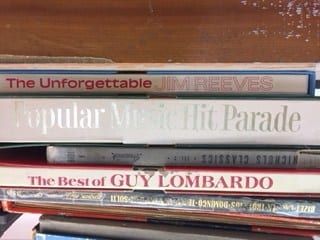
Now I consciously pick subject matter that does not interest me at all, and which I assume the average person would pass over too. As long as it’s just going to sit on the shelf anyway, I figure it’s fair game!
Buy Records in Bulk to Save Money
Even buying full price, thrift store prices are great for vinyl. Still, if you know you’re going to experiment, buy a bunch at a time. Most places will give you a discount for taking a big stack off their hands.
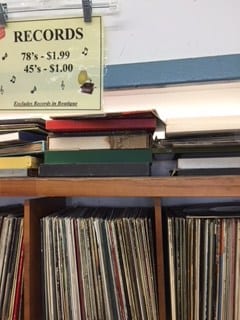 Depending on your thrift shop, you could also go on a day when there’s a promotion (I always hit 50% off day).
Depending on your thrift shop, you could also go on a day when there’s a promotion (I always hit 50% off day).
Also, I look in the section with multiple-record albums (double, triple, or box sets). I count the number of records and divide the price by that number since all albums are usually priced the same. This way, I find the most number of records for the least amount of money!
As I go through this process, I have fun trying to bargain hunt, plus I am lowering my cost of materials significantly for each piece I pour! That makes experimenting and having mixed results a lot more bearable.
For Your First Pour, Try Making a Clock
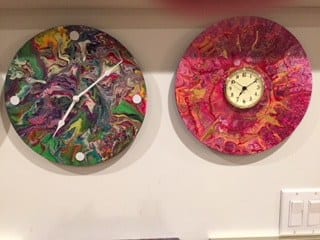
Aside from making disc-shaped paintings, I find that clocks are my go-to project when I work with vinyl.
Clockworks for retrofitting vinyl can be purchased online, at hobby stores such as Michael’s and also at woodworking shops. You can buy hands and works separately, and buy numbers for the face in another package. You can also find all three in one package and even buy in bulk sets.
Another way to turn a record into a clock is to use a small face that can be inserted into the center of the record. These are usually all in one piece. This way gives a totally different look to separate components. Either way you go, you can have great results!
Another way of doing the numbers on your clock face is to find a round piece of metal (the size of a penny) paint it and glue it at the 12 o’clock position (and as many hour markings as you like). This is a fun way to go if you know nobody in your house actually uses the numbers.
Use A Drill to Make Modifications to Vinyl
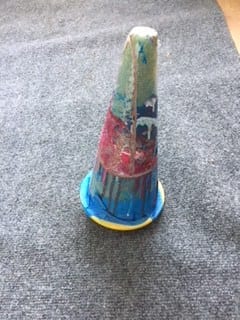
In order to use the enclosed clock face, you can find a drill bit to cut a hole the exact size of the insert into the record. This is easy to do if you find a cone the size of the cutout and use it as a guide.
Once you have all the pieces for your clock or are set up with a record to experiment with, you are ready to think about colors and ways to pour.
How to Pour-On Vinyl
One method that I like to use is to put the record on a turntable. I found a children’s toy pottery wheel for a few dollars on sale. If you’re just painting the record as is, just skip the next step!
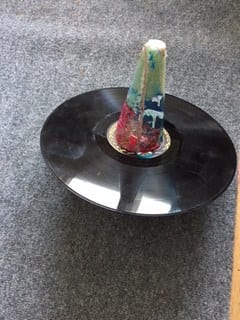
When I’m planning to make a clock, using the record with the center cut out, I use a Styrofoam cone from the hobby shop and attach it to the turning base on the toy pottery wheel.
I build a protective wall under and around the wheel and put the record on the cone.
Once I’m set up, with or without the cone, I then push the foot pedal on the turntable to make the record turn. I pour the paint from one side, starting from the center to the outer edge. This tends to make really great designs.
Pour On!
Hopefully, these tips for getting started will help you to start experimenting with painting on records. I know you will have as much fun with it as I do. If you have your own secrets or tips for working with records, please share them below in the comments!

Susan Soffer Cohn started training as an artist in the early 1990’s, after degrees in English and Business Administration. Due to the fine caliber of master teacher who mentored her, the unlikely results of becoming a full time artist came to fruition.
She is very experimental and loves to mix media to see what will happen. Susan paints, teaches, exhibits and sells her work. It has been shown in France, Sweden, Italy and Dubai, UAE as well as throughout the USA.

How do you hang the clock
Hi Verpnique, I recommend checking out this video for tips on how to hang the clock properly once poured.
The clock will has a hanger on back